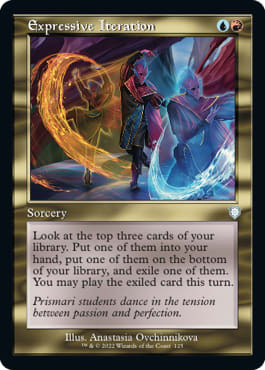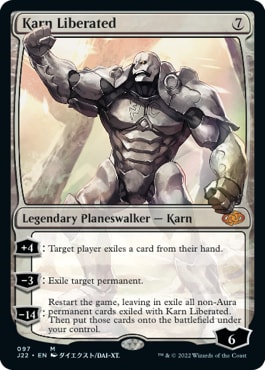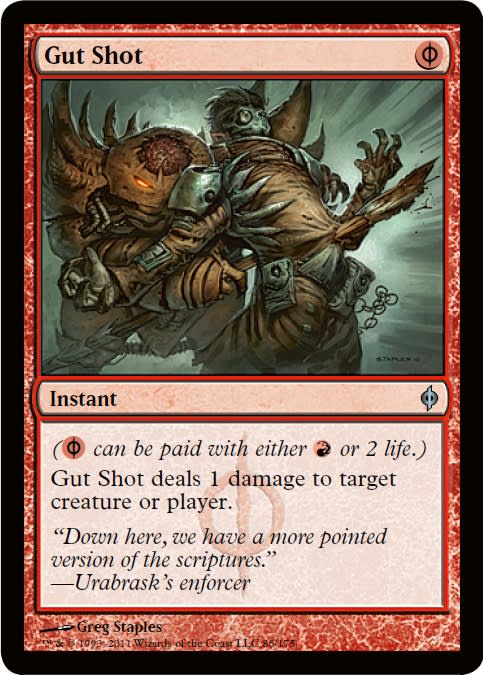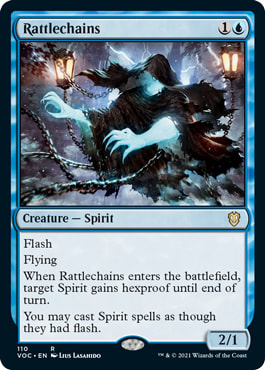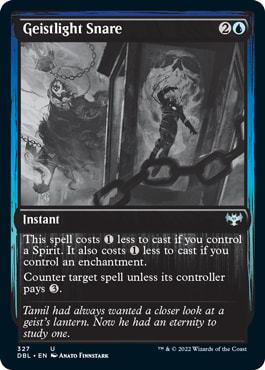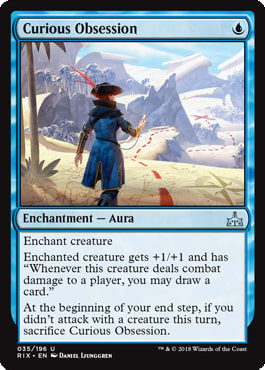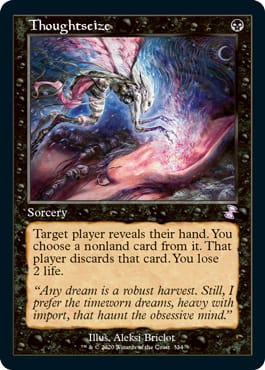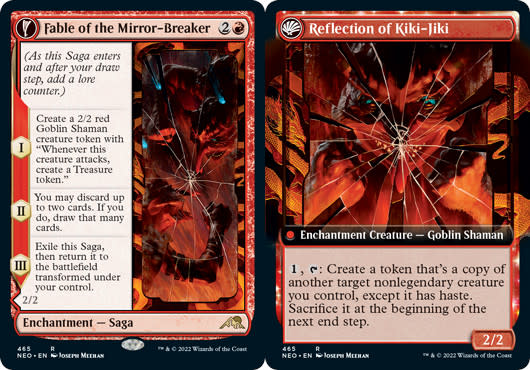Improving at Magic: the Gathering is no easy task.
Magic has been around for 30 years, and still even the best players in the world make mistakes on a game-by-game basis. Nobody has ever been able to program an AI that is able to play Magic at a high level, unlike other games like chess or video games, because there are just an astounding number of variables in each game, many of which are unknown or hidden information. It's not hard to play Magic, as in to take the game actions required to complete a game, but optimizing to the point where you are a winning player is exceedingly difficult.
So, what's the best way to do this? It may sound paradoxical, as one would logically like to start from the beginning, but thinking about the end of your games will be far more useful. Today I'm here to tell you why.
It's The Destination, Not The Journey
There are many different ways for a game of Magic to end.
Maybe it's a super tight damage race where one player topdecks a Lightning Bolt on the seemingly penultimate turn to throw off the math and win the race. Maybe it's a long midrange affair where one player accumulates more resources and grinds the other into dust. Maybe it's a control deck trying desperately to find a way to stifle a combo player from going off before they sculpt the perfect hand.
While the circumstances are often going to be very different, one thing remains true:
Thinking about how the game is going to end should be the single most important factor for your choices in the game, as well as in deck-building and sideboard planning.
You should have a clear idea of what the conclusion of games you lose look like, as well as what the conclusion of games you win look like.
Take the matchup of Izzet Murktide vs Mono Green Tron in Modern:
Izzet Murktide | Modern | karatedom
- Creatures (14)
- 3 Ledger Shredder
- 3 Murktide Regent
- 4 Dragon's Rage Channeler
- 4 Ragavan, Nimble Pilferer
- Instants (19)
- 1 Archmage's Charm
- 2 Spell Pierce
- 4 Consider
- 4 Counterspell
- 4 Lightning Bolt
- 4 Unholy Heat
- Sorceries (4)
- 4 Expressive Iteration
- Artifacts (4)
- 4 Mishra's Bauble
- Lands (19)
- 3 Island
- 1 Fiery Islet
- 1 Misty Rainforest
- 1 Otawara, Soaring City
- 3 Polluted Delta
- 3 Scalding Tarn
- 3 Steam Vents
- 4 Spirebluff Canal
- Sideboard (15)
- 1 Abrade
- 2 Blood Moon
- 1 Brotherhood's End
- 2 Dress Down
- 2 Engineered Explosives
- 2 Flusterstorm
- 2 Mystical Dispute
- 1 Subtlety
- 2 Unlicensed Hearse
Mono Green Tron | Modern | TerminalJustice
- Creatures (6)
- 2 Cityscape Leveler
- 2 Wurmcoil Engine
- 2 Ulamog, the Ceaseless Hunger
- Planeswalkers (8)
- 4 Karn Liberated
- 4 Karn, the Great Creator
- Instants (2)
- 2 Warping Wail
- Sorceries (8)
- 4 Ancient Stirrings
- 4 Sylvan Scrying
- Artifacts (18)
- 2 Relic of Progenitus
- 4 Chromatic Sphere
- 4 Chromatic Star
- 4 Expedition Map
- 4 Oblivion Stone
- Lands (18)
- 3 Forest
- 1 Blast Zone
- 1 Boseiju, Who Endures
- 1 Sanctum of Ugin
- 4 Urza's Mine
- 4 Urza's Power Plant
- 4 Urza's Tower
Izzet Murktide is a deck looking to get on the board quickly with a threat that creates a cascading early advantage like Ragavan, Nimble Pilferer or Dragon's Rage Channeler and ride that to victory while countering spells and reacting to their opponent. If the early creatures are delt with they can slide into a more controlling roll with the card advantage from Expressive Iteration and big finishers like Murktide Regent.
Mono-Green Tron is a psedo-combo ramp deck, looking to assemble the three Tron lands and cast 7 to 10 mana spells far earlier than the game intended. It excels at going over the top of whatever its opponent is doing, but trades this mid and late game power for very little interaction in the early game.
In the games that Izzet Murktide wins in this matchup, they typically get out to an early advantage with a Ragavan, Nimble Pilferer or Dragon's Rage Channeler, and spend the next few turns attacking while leaving up mana for countermagic to stop Tron's big plays on turns 3-5, finishing the game off with the creatures or maybe a few burn spells before Tron's powerful spells can take over the game. Post-board, they may be able to stick a strong hate card like Blood Moon and protect it long enough to win.
In the games that Tron wins in this matchup, the Izzet deck either is unable to produce the early threats necessary for them to leave up Counterspell on turns 3-5, meaning they need to shift into a more controlling role and try to counter every big spell that Tron casts. This means the Tron deck has time to cast a lot of different big threats, and if any one of them resolves it will almost always mean victory.
This means that if you're on the Murktide side of the matchup, it is paramount that you understand you need to be playing toward the games you're going to win. Any hand without a 1-drop should be heavily scrutinized, as failure to execute this plan will usually result in a loss.
From the Tron side, there unfortunately isn't a ton you can do about the Murktide player's best Ragavan draws. Maybe a few maindeck Warping Wail or Dismember can help turn the tide a little bit, and if you do have these tools they should be a huge priority. Even something like Veil of Summer isn't that exciting, because it delays the casting of your big spell by a turn which may not be fast enough.
While it is very narrow and specific, if you were looking to improve your Izzet Murktide matchup specifically something bizarre like Gut Shot would probably be the best answer. While it's very strange looking compared to something like Veil of Summer or even Defense Grid, you've properly identified what the games that you lose look like; you're losing to the early threat, not the counterspells. Gut Shot on their turn one Ragavan or Dragon's Rage Channeler goes a long way to shifting the texture of those games.
For another example, we can look at the Explorer/Pioneer matchup of Mono-Blue Spirits against Rakdos Midrange from last year's World Championship.
Mono-Blue Spirits | Explorer | Jim Davis, 5th Place 2022 World Championship
- Creatures (24)
- 1 Brazen Borrower
- 1 Cemetery Illuminator
- 1 Shacklegeist
- 1 Spectral Adversary
- 4 Ascendant Spirit
- 4 Mausoleum Wanderer
- 4 Rattlechains
- 4 Spectral Sailor
- 4 Supreme Phantom
- Instants (10)
- 2 Spell Pierce
- 4 Geistlight Snare
- 4 Lofty Denial
- Enchantments (5)
- 1 Combat Research
- 4 Curious Obsession
- Lands (21)
- 2 Faceless Haven
- 19 Snow-Covered Island
- Sideboard (15)
- 1 Aether Gust
- 2 Brazen Borrower
- 1 Cobbled Lancer
- 4 Ledger Shredder
- 4 Leyline of Combustion
- 2 Slip Out the Back
- 1 Witness Protection
Rakdos Midrange | Explorer | Jean-Emmanuel Depraz, 20th Place 2022 World Championship
- Creatures (17)
- 2 Kroxa, Titan of Death's Hunger
- 3 Sheoldred, the Apocalypse
- 4 Bloodtithe Harvester
- 4 Bonecrusher Giant
- 4 Graveyard Trespasser // Graveyard Glutton
- Planeswalkers (2)
- 2 Liliana of the Veil
- Instants (8)
- 1 Bedevil
- 2 Abrade
- 2 Eliminate
- 3 Fatal Push
- Sorceries (4)
- 4 Thoughtseize
- Enchantments (4)
- 4 Fable of the Mirror-Breaker // Reflection of Kiki-Jiki
Mono-Blue Spirits is a super low to the ground tempo deck looking to get under whatever it is playing against, establish some sort of board presence or engine (usually Curious Obsession), and then put their opponent off balance with cheap counterspells like Geistlight Snare and Spell Pierce while they close the door.
Rakdos Midrange is your classic midrange deck, filled to the brim with cheap removal spells as well as above rate three- and four-mana threats. It looks to styme their opponent's development with this cheap interaction, and then slam one of its many midrange threats and grind them out on pure rate.
In the games that Mono Blue Spirits wins in this matchup, they are able to get out to a fast start and accrue some sort of snowballing advantage, while staying ahead of Rakdos Midrange's removal spells with countermeasures like Spell Pierce, Rattlechains, and Geistlight Snare. Rakdos doesn't draw enough cheap removal to keep up and ends up glutted with ineffective three- and four- mana spells that they are unable to deploy and resolve fast enough to matter.
In the games that Rakdos wins in this matchup, they are able to use one-mana interaction like Thoughtseize and Fatal Push to bridge the gap to their more expensive spells, not letting Mono-Blue Spirits get rolling enough to defend their threats and engines. Once a card like Sheoldred, the Apocalypse resolves on a stable board it is difficult for Mono-Blue Spirits to come back, but the stable board point must be reached.
This means from the Mono-Blue Spirits side that it's important to have a threat heavy hand that can withstand a Fatal Push or two and still get on the board early enough to make your counterspells effective in the midgame. In some matchups you can keep a hand that's just a 1-drop, a Curious Obsession, and three counterspells because you know you can ride it to victory, but in a matchup with so much removal, cards like Curious Obsession go way down in value.
From the Rakdos side, it is paramount to have as much cheap interaction as possible. One-mana spells are the end-all be-all when it comes to keeping up with the pace of the Mono-Blue Spirits deck, because if Rakdos ever finds itself in a position where it falls behind and is trying to resolve 2+ mana spells, it can be very difficult to recover. If the Rakdos deck's first play is a Stomp on turn two, this is probably not good enough, especially on the draw.
So, with this information (and the anticipation that Rakdos would be one of the most played decks in the tournament), what did my team do at Worlds?
We understood that trying to play the pure tempo gameplan against a post-sideboard configuration of probably about 10 one-mana interaction spells was a fool's errand. Rather than seeing the end of our winning games as countering every spell they played with a Curious Obsession attached creature attacking every turn, we decided to see our deck more like a pure beatdown deck, with Leyline of Combustion punishing our opponent for every removal spell (and especially Thoughtseize) they would cast. We boarded out many of our counterspell elements and Curious Obsessions, because those tools didn't fit the narrative of games we were likely to win.
Now the end of the game looked like a midrange deck trying to kill every creature while they bleed off life points over and over again, while the now Mono-Blue Beatdown decks slams creature after creature that are far more efficient and difficult to block than their threats until they die.
Craft The Ending You Want To See
These examples touch on all parts of Magic that are under your control, from actual gameplay, to sideboarding, to deck construction, and this concept of visualizing how you expect the end of your winning games to look is a huge part of that.
This can be something as simple as looking to make creature combat trades early when you think you're the deck that has the long game inevitability, to trying to sideboard your heavy control deck in a manner where you can be more of a tempo deck (even perhaps bringing in ineffective threats like Kor Firewalker against a non-Red deck) with counterspells when playing against a combo deck that will eventually craft the perfect hand if you give them enough time.
If you ever find yourself confused about a game, how to sideboard, or how to craft your decklists for a certain matchup, this heuristic is a simple and effective one to return to that will help guide your thought process. It's extremely important in Magic to have a purpose to all of your choices, and knowing what your goals in each game are help to galvanize that purpose into something clear and actionable.


















